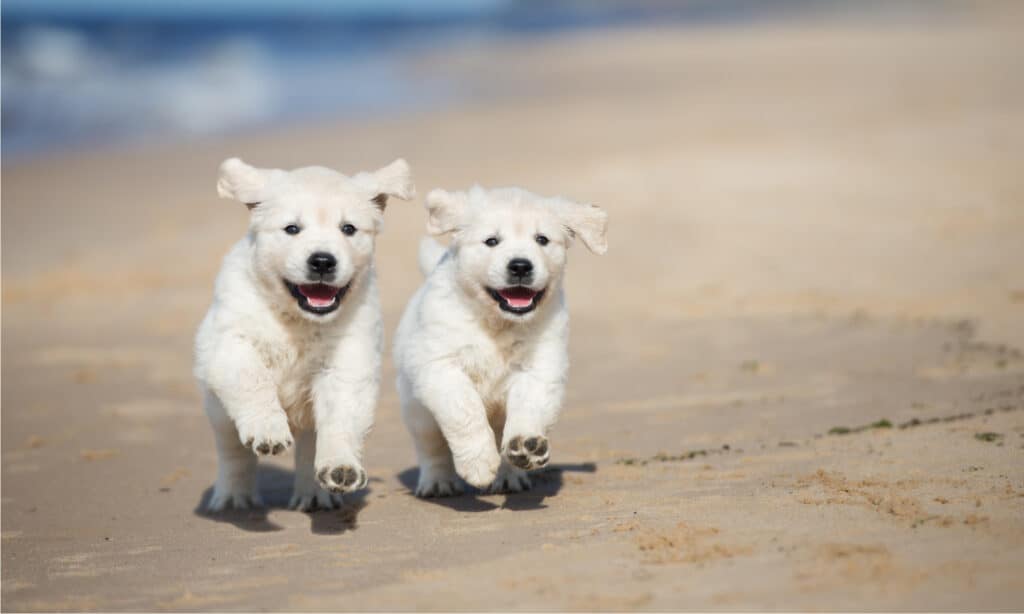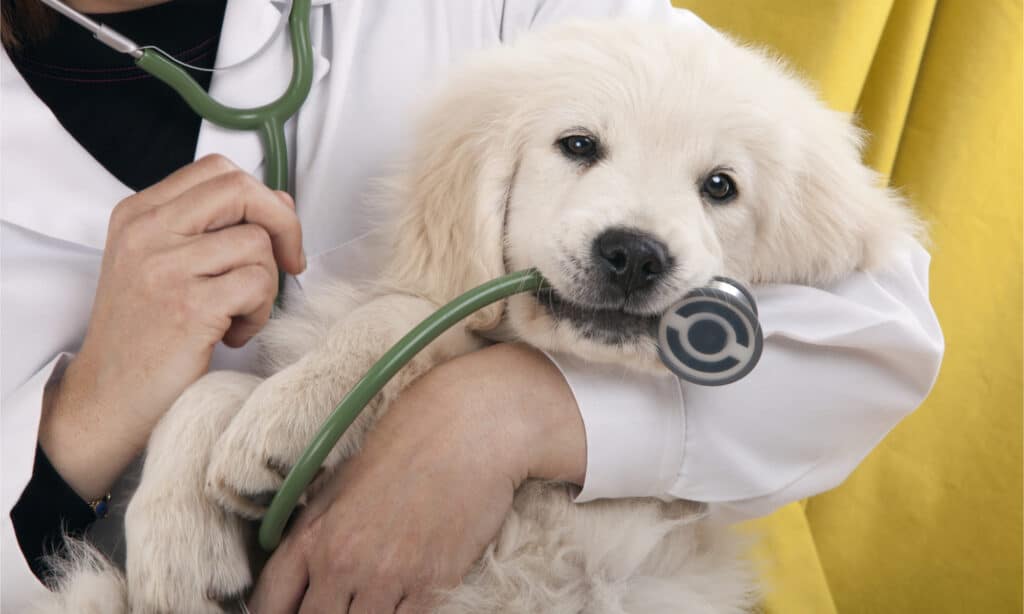Golden retrievers are an incredibly popular dog breed around the world for their amicable, loyal temperaments and gorgeous golden coats. Their charm begins in puppyhood with fluffy fur, oversized paws, and utterly loveable personalities. Read on to discover eight fascinating facts about baby golden retrievers!
1. Baby Golden Retrievers Are Fluffy for a Reason

Golden retriever puppy fur is fluffy in order to keep them as warm as possible in their first three months of age.
©MPH Photos/Shutterstock.com
Young golden retriever puppies are unbelievably touchable with incredibly soft, fluffy coats. Though born wet, they quickly dry out and fluff up into tiny golden balls of fur. But this isn’t just for the sake of being cute. Golden retriever puppy fur is fluffy in order to keep them as warm as possible in their first three months of age. It’s an adaptation that disappears as they develop, giving way to the famous sleek golden coat of their parents. However, the puppy fur doesn’t disappear altogether. It remains as the undercoat under a layer of adult feathering.
Though a golden retriever’s coat is thin and short during the puppy phase, it still sheds. Regular brushing will not only control the shedding but will also encourage the puppy to get used to grooming throughout its life.
2. Golden Retriever Puppies Lose Their Teeth
Just like humans, dogs lose their puppy teeth and replace them with adult ones. Golden retriever puppies lose their 28 puppy teeth by about four months of age. Their 42 adult teeth begin coming in around this time and should be fully in place by around six months of age.
This is a relief to most golden retriever owners. Not only are puppy teeth extremely sharp, but puppies have no compunction about using them. This particular breed is highly playful and may frequently nip, despite being good-natured. As puppy teeth begin to drop out, the puppy itself begins to gain more maturity and nips less. Teething toys help reduce the pain associated with this process.
3. A Golden Retriever Litter May Have More Than One Father

Female golden retrievers are capable of becoming pregnant by more than one male during mating season.
©otsphoto/Shutterstock.com
Just because several similar golden retriever puppies share a litter doesn’t mean they all share a father. Female golden retrievers are capable of becoming pregnant by more than one male during mating season. This means they can give birth to puppies fathered by more than one male dog, including dogs of different breeds. As long as a female mates with different males on different days, she stands a chance of bearing a mixed litter.
4. Golden Retriever Puppies Eat Three Times a Day
Most people are used to feeding their dogs twice a day, but baby golden retrievers need food on a more frequent basis. Golden retriever puppies should receive food three times a day starting at the age of eight weeks. This schedule should continue until they reach six months of age. At this point, owners can reduce the frequency of daily meals from three to two.
This doesn’t mean that puppies eat more food than adults. Their portions will simply be smaller to accommodate their frequent feedings. It’s vital to provide growing golden retriever puppies with a steady source of energy throughout the day to support growth and development.
5. Too Much Exercise Is Bad for Baby Golden Retrievers
Though it may sound counterintuitive, too much exercise can actually harm a golden retriever puppy. Its bones and muscles are still developing and can’t take the kind of strain an adult easily absorbs. Excessive exercise puts strain on a puppy’s bones and may cause temporary or permanent disability.
Because golden retrievers have so much energy, it’s easy to overestimate how much exercise a puppy should get. To prevent overexertion, plan specific times of day to engage your puppy, including playtime and walks or runs.
6. Golden Retriever Puppies Go Through a Rebellious Stage

Golden retriever puppies experience raging hormones and mood fluctuations that may lead to unwanted behaviors.
©Roger costa morera/Shutterstock.com
You might expect your lovable, affable golden retriever puppy to never change its temperament, but that expectation will only lead to disappointment. Though it varies from individual to individual, golden retriever puppies all go through some form of adolescence as they approach adulthood. Just like human teenagers, they experience raging hormones and mood fluctuations that may lead to unwanted behaviors.
This “rebellious stage” is worst from eight to 18 months of age, though it may begin as early as five months. During this time, your puppy’s attention span will be shorter; it will display increased excitability, and it may engage in destructive behaviors like indiscriminate chewing. Patience and consistent training are essential at this time in a puppy’s life. Don’t worry: at some point, its temperament should even out as it matures.
7. Baby Golden Retrievers’ Eyes May Change Color
Golden retriever puppies are born with their eyes shut, meaning they can’t see for the first two weeks of their lives. When their eyes do open, the blue coloration surprises some dog owners, who expect the typical rich brown of adult golden retrievers.
The blue color is the result of a lack of pigment in the early stages of a golden retriever puppy’s development. During this time, its eyesight isn’t that good, and it will rely heavily on its senses of smell and hearing. However, with time, that blue color will transition into a lovely brown, and its eyesight will improve.
An adult golden retriever with blue eyes is most likely not a purebred. Crossbreeding with huskies, cocker spaniels, border collies, and various other breeds sometimes produces this unusual genetic trait. Unfortunately, blue eyes in a golden retriever may also signal health issues like cataracts or nuclear sclerosis.
8. Golden Retriever Puppies Get Darker as They Mature

Golden retriever coats tend to darken into a richer shade of gold, yellow, cream, or even red, as they age.
©iStock.com/Photology1971
Golden retrievers typically start life with light golden or blond coats. However, this is likely not their permanent coat color. As they mature, golden retriever coats tend to darken into a richer shade of gold, yellow, cream, or even red.
The best way to determine the true color of a purebred golden retriever puppy is to look at its parents. For mixed-breed golden retrievers, a good tip is to look at their ears. Like most dogs, aging golden retrievers will develop light or gray patches around their muzzles and eyes.
Though golden retrievers begin life as bumbling, fluffy puppies, they soon grow into athletic, mature adult dogs with a great capacity for love and obedience.
Up Next:
- 10 Incredible Golden Retriever Facts
- Golden Retriever Lifespan: How Long Do Golden Retrievers Live?
- English vs. American Golden Retriever: 5 Differences
The photo featured at the top of this post is © otsphoto/Shutterstock.com
Ready to discover the top 10 cutest dog breeds in the entire world?
How about the fastest dogs, the largest dogs and those that are -- quite frankly -- just the kindest dogs on the planet? Each day, AZ Animals sends out lists just like this to our thousands of email subscribers. And the best part? It's FREE. Join today by entering your email below.
Thank you for reading! Have some feedback for us? Contact the AZ Animals editorial team.







